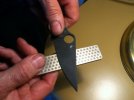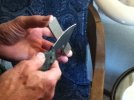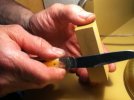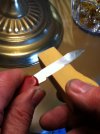another aspect of all this is:
freehanding the same knife over and over again over years, to me, feels like being at the hairdresser's. at every visit he uses a slightly different approach/technique --for no reason other than not having a fixed mindset--, even though i want the same outcome, the same haircut as always.
Same situation with my knife: even though my only objective is to get it scary sharp, with least efforts possible (shortest most effective path), also with least steel consumption, and hopefully not wasting any time (i.e. making errors on the path), i don't end up following the exact same path as in my last sharpening session of the identical knife. of course, it all starts with the very condition of the blade (the apex line, blunted spots). but then my strokes take off, i use unprecedented stroke/stone variations, and i wonder why the heck this freehanding session turns out so different from my last one (a week earlier, for example). and that's when i get reminded of my visits at the hairdresser's. funny thing.
makes me realize that freehanding and haircutting have the thing in common: it's authored highly personally/individually, can depend on day's mood, is performed in a flexible manner, includes spontaneous decision-making and minute technique variations, all in the belief and hope that one's still on the right track.
( the haircutter's analogy was valid when i was wearing longish hair for years ugh; nowadays i clip my hair on my own with a 2xAA-powered WAHL

, actually branded MOSER )




